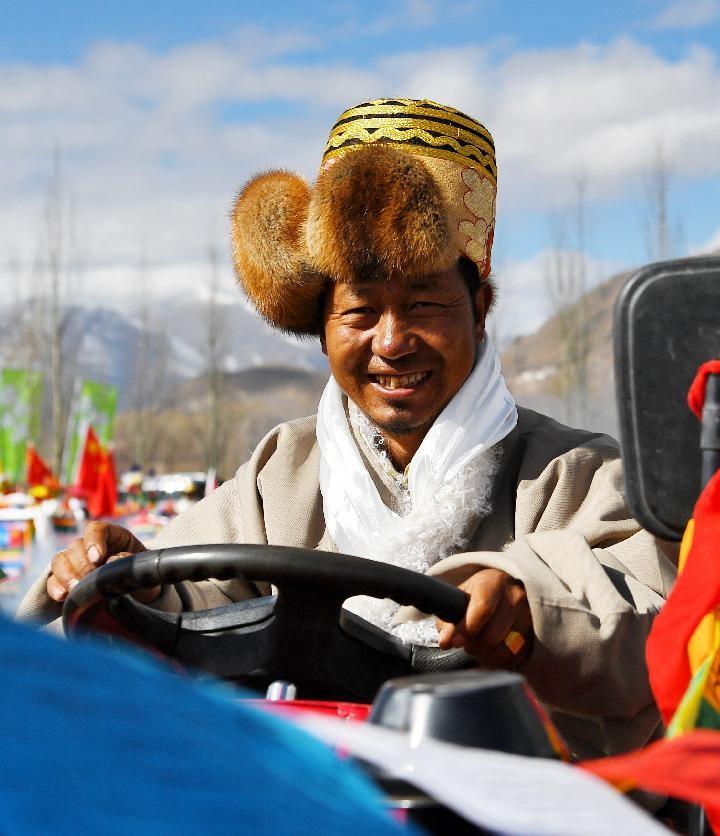Source:Xinhua 2023-03-20

A local farmer dressed up in traditional Tibetan costume casts a handful of seeds at a spring plowing ceremony held in Changga Village in southwest China's Tibet Autonomous Region, March 16, 2023. (Xinhua/Jigme Dorje)
LHASA, March 18 (Xinhua) -- Dressed up in traditional Tibetan costume, Nagwang Dekyi and her fellow villagers from Changga Village in southwest China's Tibet Autonomous Region took part in a grand spring plowing ceremony on Thursday.
The ceremony holds great significance as it marks the beginning of a new year's farming season and serves as a prayer for favorable weather and bountiful harvests. It is considered the most important ritual in the farming regions of Tibet.
This was the 20-year-old college graduate's first spring plowing ceremony, and she noted that it was vastly different from what she remembers from her childhood.
"When I was a child, I witnessed farmers plowing fields with yaks. However, now tractors have replaced them. I am amazed to see drones being used to spread pesticides in the fields," Nagwang Dekyi said.
During the ceremony, 33 tractors plowed the farmland, and Nagwang Dekyi, along with other villagers, diligently sowed highland barley seeds.
According to Tashi Tsering, a 56-year-old local farmer, previously it took them at least two weeks to sow the seeds, but now it only takes three days, thanks to modern equipment.
For over 2,400 years, Tibetan farmers had used the traditional method of tying a wooden pole around the necks of two yaks to pull the plow. However, the use of modern machinery has since replaced this ancient farming practice.
Due to the widespread adoption of agricultural mechanization in the region, Tibetan farmers have increasingly turned to advanced and convenient mechanized farming tools, making them a preferred choice over traditional yak-plow farming. As a result, the latter has gradually faded out.
Tsering Lhamo, now 96 years old, recollects that during the olden times in Tibet, there was a scarcity of farm tools but today the scene is totally different.
The democratic reform of 1959 ushered in a new era in Tibet. Millions of iron farm tools were distributed for free to farmers and herdsmen throughout the region, replacing the outdated wooden tools. In the 1970s, tractors were introduced to farmers in the region known as "the roof of the world."

A local farmer dressed up in traditional Tibetan costume pilots an agricultural machine at a spring plowing ceremony held in Changga Village in southwest China's Tibet Autonomous Region, March 16, 2023. (Xinhua/Zhang Rufeng)
At present, modern machinery is extensively utilized in all aspects of agricultural production on the Qinghai-Tibet Plateau.
By the end of 2022, Tibet had 545,600 units of modern agricultural machines, including 287,000 tractors, according to the regional department of agriculture and rural affairs.
In addition, the country has rolled out subsidies for the purchase of agricultural machinery. According to official data, the central and the regional governments have offered subsidies of 2.45 billion yuan (about 354.8 million U.S. dollars) for purchasing agricultural machinery in the region since 2005.
"Driving a tractor has become a fundamental skill for farmers," said 69-year-old Phurbu Dorje, who takes pride in being the first tractor operator in his village located in Shannan City.
Copyright © Xizang Daily & China Xizang News All rights reserved
Reproduction in whole or in part without permissions prohibited
Index Code: 藏 ICP 备 05000021 号
Producer: Xizang Daily International Communication Center